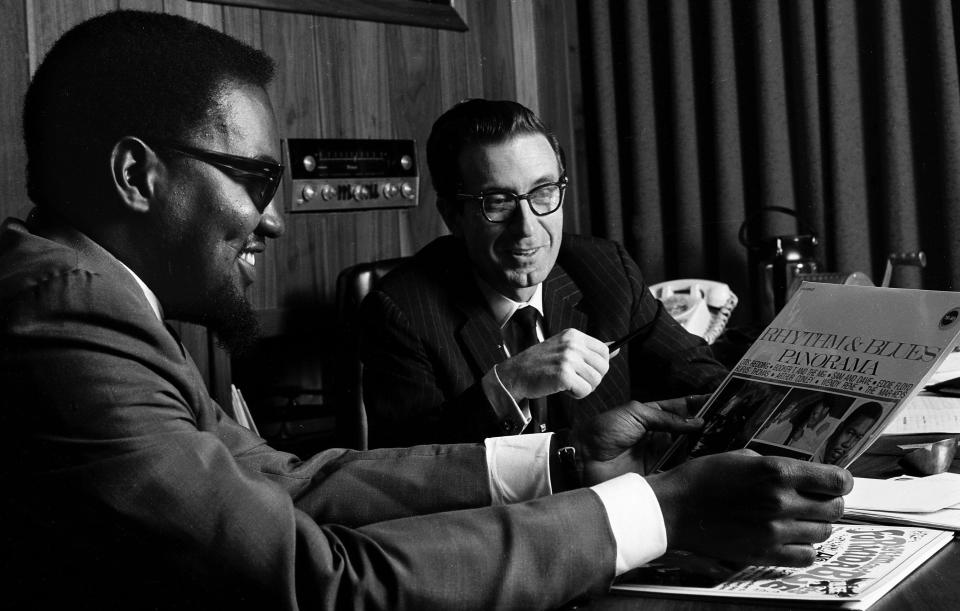Stax Records co-founder, Rock 'n' Roll Hall of Famer Jim Stewart dies at 92
It’s one of the strange twists of history that the greatest, funkiest soul label in the world, one of the most powerful outlets for Black expression, was started by a white hillbilly fiddler named Jim Stewart.
Stewart — the co-founder of Memphis’ Stax Records — died on Monday at the age of 92. He died “peacefully, surrounded by his family,” according to a statement released by Stax Museum of American Soul Music, which confirmed his passing.
Stewart was inducted into the Rock ‘n’ Roll Hall of Fame in 2002, and the institution noted that, “as producer, engineer, businessman and mentor, Jim Stewart was at the center of it all.”
To those who knew and worked with Stewart at Stax, his generosity of spirit, and his willingness to open doors — particularly to young Black musicians — was life-altering. “Stax Records would not have existed, soul music would not have been what it was if not for what Jim did and for who he was,” said David Porter, Stax’s Hall of Fame songwriter.
“Jim will forever be revered for providing the opportunity for me — and so many others — to do what we did. Regardless of how talented we might’ve been, our music would not have existed had Jim not been willing to open that door — to his studio, to his record company and to his heart. Jim was a catalyst, and we’ve lost a real pioneer.”
Memphis music:Stax Records alumni salute founder Jim Stewart during emotional museum event
A banker by trade, the mild-mannered Stewart was an unlikely convert to R&B and soul music, but he would create a racially mixed record company in the heart of the segregated South of the 1960s, helping shape some of the most influential works in American music.
“Mr. Stewart was the unpretentious soft-spoken diminutive white guy with a Brylcreem lathered hair part and dark fat-rim glasses that I met in 1962,” recalled Deanie Parker, longtime Stax publicist and later Soulsville Foundation president. “He gave us opportunities denied to most Blacks in America, and we gifted him an indelible Memphis sound that ‘together’ we created at Stax Records.
“The best part of our affable city is the music created in the heart of South Memphis," added Parker. "Real, forever Memphis music is timeless authentic art that teaches and touches your soul like those iconic [sounds] recorded from 1957 to 1975 on the record label Jim Stewart started.”

From banking to releasing records
Born on July 29, 1930, in Middleton, Tennessee, a rural area 70 miles east of Memphis, Stewart came up in a musical family, playing gospel with his sisters, father and uncle. A fan of Western swing bandleader Bob Wills, Stewart took up fiddle as a boy. “I’m a hillbilly at heart. I grew up listening to the Grand Ole Opry,” Stewart said during a rare public appearance at the Stax Museum in 2018.
After graduating high school, Stewart moved to Memphis, worked as a stock clerk and then completed his military service, during which he played fiddle in the special services. After getting a business degree at Memphis State University, he began work at First National Bank in the bond department. Stewart was also studying for a law degree and playing fiddle on the weekends in a group called Canyon Cowboys.
By 1957, Memphis had become a hotbed of independent record studios and labels, led by Sam Phillips’ Sun Records. Stewart began to see the possibilities in producing records. “I recognized my limitations,” Stewart told author Robert Gordon. “I knew that I could not make it as a musician, so producing was the next best thing. It was an outlet for me to express myself musically."
Stewart would eventually launch his own label, Satellite, in 1957, after having had a couple songs he’d recorded rejected by Sun and various other local and regional labels. Early on, Stewart linked up with rockabilly guitar player and aspiring producer named Lincoln “Chips” Moman and began making recordings — initially out of Stewart’s garage and then an early studio in Brunswick, Tennessee.
With the financial help of his sister, fellow bank employee Estelle Axton, they were able to purchase a new Ampex tape recorder and began releasing records (the company would later change its name to Stax — a combination of Stewart's and Axton’s last names).
In his 2018 appearance at the Stax Museum, Stewart praised his sister with taking the ultimate risk to build the label. “She deserves all the credit for Stax Records. Because she borrowed money, she mortgaged her home, in order for us to start a record company,” he said. “Without that … this would never have happened.”
Stax an anomaly in segregated South
In 1959, the still fledgling Satellite label would find a new and permanent home in South Memphis, at the site of the former Capitol Theater at McLemore and College. Located in an increasingly Black neighborhood, the move — largely ushered by the R&B-inclined Moman — would change the trajectory of the company and Stewart’s life.
By this point Satellite had been cutting country and pop songs unsuccessfully for almost three years. With money and prospects dwindling, Stewart welcomed a chance to record an R&B duet, “Cause I Love You,” by veteran Memphis singer, entertainer and DJ Rufus Thomas, who'd come by the studio with his 16-year-old daughter, Carla.
Memphis music history:Bluff City bicentennial: 200 Memphis music moments
Within a few months of its release “Cause I Love You” had become a regional hit selling several thousand copies in Memphis, Nashville and Atlanta. Its success piqued the interest of New York’s Atlantic Records and company executive Jerry Wexler, who began a distribution relationship with Satellite.
Just as importantly, the success of “Cause I Love You,” brought Stewart to understand the value of R&B and the opportunity to make that music the thrust of his label. As Stewart told Stax historian Rob Bowman, “Prior to that I had no knowledge of what Black music was about,” he said. “It was like a blind man who suddenly gained his sight.”
Before long, Carla Thomas would break things wide open as a solo act with her hit “Gee Whiz” — which sold half a million copies — and Rufus Thomas’ “Walking the Dog,” would also chart, and Stax Records (as Satellite was officially renamed in 1961) was off and running. Soon, other chart hits would follow, including the Mar-Keys’ “Last Night” and Booker T. & the MG's' “Green Onions,” as well as the arrival of Georgia singer Otis Redding.
Over the next few years, Stax would largely tap the talents of a core of young Black neighborhood kids from South Memphis to make its records: Booker T. Jones, William Bell, David Porter and Isaac Hayes, among them. It was this remarkable contingent of artists who would come to define the Stax sound, as Stewart produced and guided the label through its early years (following the departure of Moman in 1962).
While the hits were memorable, the environment at Stax — a company where Black and white people worked and made music shoulder to shoulder — was an anomaly in the segregated South of the '60s. Stewart remained keenly aware of the inequities of the era outside of his label. In 2018, he recounted the story of taking the Stax’s breakout star Carla Thomas to meet with Atlantic vice president Jerry Wexler.
“Even though Carla had a hit in the top 10 nationwide, we could not go to a restaurant in this city and have dinner together,” Stewart said. “We went to the Claridge Hotel [where Wexler was staying] and we had to go upstairs on the freight elevator. That was one of the worst feelings I’ve ever had in my life. Here’s a young lady who was a [star], and she could not walk through the lobby of the Claridge Hotel. It was one of those moments in your life you’d like to forget. But I’ll never forget that.”
Al Bell: At Stax 'you had harmony'
Stax would continue to thrive into the mid-1960s, with the success of Carla Thomas, Sam & Dave, Booker T. & the MG’s and ascent of its brightest star, Redding.
In 1965, Stewart would hire a young Black disk jockey from Arkansas, Al Bell, to head the label’s promotions. Bell and Stewart had first met in the late ‘50s at Memphis radio station WLOK. At Stax, Bell and Stewart shared an office, and in the process forged an unusual bond.
“I was amazed to sit in the same room with this white guy who had been a country fiddle player,” Bell told author Robert Gordon. “We had separate water fountains in Memphis and throughout the South. And if we wanted to go to a restaurant, we had to go to the back door — but to sit in that office with this white man, sharing the same telephone, sharing the same thoughts, and being treated like an equal human being — was really a phenomenon during that period of time.”

“The spirit that came from Jim and his sister Estelle Axton allowed all of us, black and white, to come off the streets, where you had segregation and the negative attitude, and come into the doors of Stax, where you had freedom, you had harmony, you had people working together. It grew into what became really an oasis for all of us.”
In the late-'60s, after a run of chart hits, Stax would suffer a series of unexpected blows: the death of Redding in a 1967 plane crash, the company’s break with distribution partner Atlantic in 1968, and the pall cast over Memphis following the assassination of Martin Luther King Jr. that spring.
After splitting with his sister Estelle Axton in 1968, Stewart and his new partner, Al Bell, would relaunch Stax with the backing of entertainment conglomerate Gulf & Western. Although Stax had lost its entire back catalog due to a contractual loophole with Atlantic, the company charged into its second phase with a “Soul Explosion”, issuing 27 new albums at once and reviving the label’s fortunes.
Stax Museum of American Soul Music:Stax Museum to mark 20th anniversary in 2023: Here's a look at how it plans to celebrate.
Celebrating Jim Stewart's legacy
By the early-‘70s, Stax was becoming an entertainment juggernaut. The company was growing in all directions, expanding its business dramatically, while moving toward an increased sense of Black awareness and empowerment, exemplified by events like the massive WattStax concert and Isaac Hayes’ Oscar-winning soundtrack to the Blaxploitation hit “Shaft.”
Al Bell would ultimately assume control of the company, buying out Stewart with the help of CBS Records. Despite Stax’s success, by 1974 myriad forces — including the company’s creditors and the IRS — had descended on the label. In 1975, Stax suddenly found itself in dire financial straits and on the verge of collapse.

Though Stewart had become a wealthy man, when Stax began to face financial trouble, he poured much of his fortune back into the company. When Stax was finally swallowed up by creditors and shuttered in 1976, Stewart lost nearly everything. In 1981, he was forced to sell his possessions at auction, as the IRS seized his home and kicked him and his family out.
Thanks to some holdings in his wife’s name, Stewart was able to build his life back up financially and did eventually return to recording in the early ‘80s, producing projects for several veteran Stax artists. In later years, however Stewart largely removed himself from the music business and the public eye.
Over the last 20 years, Stewart continued to maintain a low profile, occasionally visiting the Stax Museum of American Soul Music, which opened in 2003, on the site of the original studio. Stewart was most proud of the work of the Stax Music Academy which fostered the talents of young Memphis musicians, just as the label had decades earlier.
Stewart did make an emotional public return to the Stax in 2018, as part of a celebration of his legacy, where his original fiddle was donated to the museum’s permanent collection.

During that event, a microphone was passed around the room to allow the Stax alumni in attendance to announce themselves. Carla Thomas — the Queen of Stax — addressed Stewart. “Jim, any crown that anybody says they wear at Stax Records, well, you’re a jewel in their crown,” Thomas said. “I love you.”
The evening’s benediction came from Al Bell, who summed up the affection for Stewart and his role in history.“All of us became a part of your dreams and visions … and we thank you for that, Jim Stewart,” said an emotional Bell. “If you had not come along when you came along, our lives would have never been the same. Thank you and God bless you.”
After the ceremony, Stewart seemed moved by the outpouring from so many old friends. “I’m speechless,” Stewart said softly, overwhelmed by the tributes.
Stewart is survived by three children — Lori Stewart, Shannon Stewart and Jeff Stewart — and by grandchildren Alyssa Luibel and Jennifer Stewart. Plans for a memorial service are pending.
The family request that in lieu of flowers, memorial donations be made to Stax Music Academy.
This article originally appeared on Memphis Commercial Appeal: Jim Stewart, Stax co-founder and Rock 'n' Roll Hall of Famer, dies
